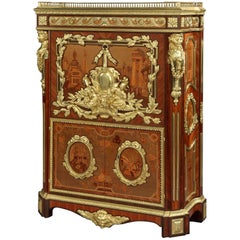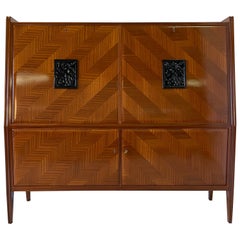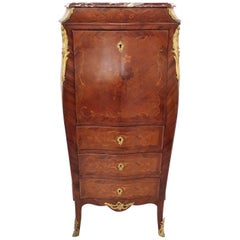Purpleheart Secretaires
2
to
2
2
2
2
1
1
2
Height
to
Width
to
Depth
to
46
1,662
497
393
345
2
1
1
1
Material: Purpleheart
Rare French Marquetry and Gilt Bronze Secretaire with Architecture Scenes
Located in London, GB
A Truly Magnificent 19th century Secre´taire a` Abattant by Maison Rogie´ of Paris After the original in the Wallace Collection, London, made in 1777 by Pierre-Antoine Foullet
Con...
Category
19th Century French Louis XV Antique Purpleheart Secretaires
Materials
Carrara Marble, Bronze
English Regency Period Secrétaire Cabinet with Egyptian Motifs
By George Oakley
Located in London, GB
A secrétaire cabinet of the Regency period
Firmly attributed to George Oakley.
Constructed in a finely faded and patinated goncalo alvez, having holly and purple heart stringing;...
Category
19th Century English Regency Antique Purpleheart Secretaires
Materials
Purpleheart, Satinwood, Holly
Related Items
Italian Mahogany Secretaire Cabinet, 1950s
Located in Meda, MB
Precious cabinet secretaire produced in Italy in the 1950s,
The whole cabinet is veneered in mahogany with a fine solid wood carving in the center of the two doors representing two b...
Category
1950s Italian Mid-Century Modern Vintage Purpleheart Secretaires
Materials
Mahogany, Maple
19th Century Bombe Marquetry Secrétaire à Abattant, Marble Top and Bronze Mounts
Located in Miami, FL
19th century bombe marquetry secrétaire à abattant, marble top and bronze mounts.
Offered for sale is a late 19th century Louis XV styl...
Category
Late 19th Century French Louis XV Antique Purpleheart Secretaires
Materials
Marble, Bronze
H 51.25 in W 27.75 in D 15 in
Biedermeier Writing Desk Chiffonier Secrétaire Cabinet Swedish Ormolu Detail
Located in LONDON, GB
Swedish antique Biedermeier writing desk chiffonier secrétaire cabinet in highly quilted golden birch veneers and finished in the Classic light h...
Category
Late 19th Century Swedish Biedermeier Antique Purpleheart Secretaires
Materials
Birch
H 55.12 in W 43.31 in D 18.9 in
Art Deco Secretaire Cabinet by Jules Deroubaix
Located in North York, ON
This Jules Deroubaix display cabinet secretaire is timeless, functional, and effortlessly chic. Made of burl sandalwood, it showcases a drop door paneled wit...
Category
1930s French Art Deco Vintage Purpleheart Secretaires
Materials
Chrome, Brass
Cabinet Secretaire by Cees Braakman for Pastoe, 1950s
By Cees Braakman, Pastoe
Located in amstelveen, NL
A wonderful piece from the Birch - series with distinctive laced legs. Designed by Cees Braakman for Pastoe in the early 1950s. Bookcase with 2 shelves an...
Category
1950s European Mid-Century Modern Vintage Purpleheart Secretaires
Materials
Birch
Antique Specimen Cabinet, French Oak Cupboard, Secretaire, Desk, circa 1850
Located in Hele, Devon, GB
This is an antique specimen cabinet, a French, oak cupboard offering a secretaire desk dating to the late 19th century, circa 1850.
In a de...
Category
Mid-19th Century French French Provincial Antique Purpleheart Secretaires
Materials
Oak
H 36.62 in W 33.47 in D 22.05 in
Biedermeier Secretaire
Located in Pompano Beach, FL
Biedermeier secretaire made of walnut, root wood and ebony with a fall front writing surface, interior drawers and secret compartments.
Category
19th Century Antique Purpleheart Secretaires
W029 Cabinet, Citronnier Wood & Marble with Gilt Bronze & Gold, Zanaboni
By Zanaboni
Located in MEDA, IT
W029 is a masterpiece cabinet in citronnier, with 46 marble “Bianco B” elements, crystal bowls, 70 Kg of brass details finishing gold 24 Kts, bas-relief in marble, inlaid in mother o...
Category
21st Century and Contemporary Italian Art Deco Purpleheart Secretaires
Materials
Wood
H 90.56 in W 56.3 in D 20.87 in
Charles Spooner Arts & Crafts Oak secretaire Cabinet with Serpentine Stretchers
By Charles Spooner
Located in London, GB
Charles Sydney Spooner, probably made by J H Brandt.
A rare oak secretaire cabinet on stand, with quarter veneered panels to the doors and drawers with black and green diamond shaped handles. The doors open to reveal adjustable shelves. The sides and lower stand are all made from solid quarter sawn oak with beautiful figuring. The slightly graduated mouldings to the waist frame the tidy little writing area. Standing on squashed ball feet, united with serpentine entwined stretchers.
This is an oak variation of the cabinet Charles Spooner exhibited at the Arts and Crafts Exhibition Society in 1910. One can see that both cabinets are essentially the same design, one with drawers one with a pull down writing area. Both have quartered veneered panels to the doors, the Mahogany one with applied moulded decoration to the doors.
See : illustration below from : Arts and Crafts Furniture by John Andrews.
See also : Charles Spooner Arts and Crafts Architect, page 209 illustration 10:28.
: Fine Art Society for a Coromandel variation and Puritan Values : Important Furniture Page 1, for a larger four door lacquered panelled variation.
Charles Spooner is noted as one of the most influential people and also credited as one of the fathers of the Arts and Crafts Movement.
Born at St Mary's Hospital, Paddington (London), Spooner was the second of 5 children of Charles Spooner and Sarah Frances Trinder, who lived at Brook Green, Hammersmith. Spooner became an architect and an instructor of furniture design at the London County Council's Central School of Arts and Crafts. He was a pupil and then assistant of Sir A W Blomfield and in 1890 won the RIBA’s Soane Medallion (Proc RIBA). He specialised in smaller churches and houses turning out some beautiful and complete buildings. He was influenced by E W Godwin and contemporary American architects such as H H Richardson. He was a member of the Society and Protection of Ancient Buildings and the Art Workers Guild, he worked in the tradition of William Morris, teaching...
Category
1920s English Arts and Crafts Vintage Purpleheart Secretaires
Materials
Oak
H 78 in W 39.5 in D 16.75 in
Biedermeier Secretaire
Located in Pompano Beach, FL
Biedermeier secretaire made of walnut, rootwood and ebonized wood. It has a fall front writing surface with interior drawers and a cubby hole. Lower section with exterior drawers.
Category
19th Century Antique Purpleheart Secretaires
Materials
Wood
King George I Ambassadorial Secrétaire-Cabinet
Located in New Orleans, LA
This highly important secrétaire-cabinet was crafted for and specially ordered by King George I for the British Ambassador to Russia. From its craftsmanship and materials to its exceptional artistry, it is a work of royal and historic significance that exudes power in each and every detail. The broken pediment at its apex features the simplified royal coat of arms bearing the king’s crown, while the interior is adorned by portraits of the British Royal Family. Placed within the ambassador’s St. Petersburg home, this entirely unique piece of furniture would have been a potent reminder of England's grandeur and political importance.
Relations between England and Russia during this period were at an all-time high. Peter the Great had traveled to England in 1698 as part of his widely known “Grand Embassy” tour, wherein he attempted to gain foreign support against the Ottoman Empire. He spent a period of nearly four months there, meeting with King William III and his court on numerous occasions. Noted academic Arthur MacGregor wrote concerning the impact of the trip, “For two decades following Peter's visit, British influence in Russia reached a peak. It manifested itself in social custom, in craft practice and in ships and naval organization... it reached a significant sector of the population before relations cooled once again and the two nations pulled back from this era of unprecedented cordiality.”
First and foremost, however, it is a reminder of British might and influence. By the reign of King George I, England had come into its own as a world power. Unique in its design, this cabinet is a reflection of the country’s might. It is crafted from the highest-quality solid walnut and burr walnut adorned by gilded lock plates and engraved hinges. The presence of ormolu at its apex and lining the doors was a rarity for this period, and its addition makes manifest the importance of the design.
The outer doors open to reveal multiple interiors, including fifteen separate drawers around a central cupboard; the cupboard doors each bear mezzotint portraits of George I and his father, Ernest Augustus, Elector of Hanover. An etching after the portrait of George I dating to circa 1716 is in London’s Royal Academy. A second, inner pair of doors are adorned by mezzotints of the Prince and Princess of Wales (later Queen Caroline and George II), which are both after portraits by Sir Godfrey Kneller dated 1716 in the Royal Collection. A final portrait is revealed on the very interior of the cabinet, where a mezzotint of Frederick, Anne, Amelia and Caroline, children of the Prince of Wales, resides. An etching (circa 1715-1720) after this portrait can be found in the National Portrait Gallery (London).
Apart from its abundance of royal portraiture, the cabinet features stunning painted decoration, including floral designs as well as clouds, birds and trees in a bucolic motif reminiscent of Eden. Its lower portion is a study in both form and function, featuring a fitted secrétaire-drawer above three additional drawers for storage. The cabinet appears in The Shorter Dictionary of English Furniture by R. Edwards from 1964, a text that is regarded as the bible of British furniture design. Edwards describes it as a “writing cabinet...given by George I to the British Ambassador at the Russian court.”
The cabinet was likely made for the 18th-century German diplomat and writer Friedrich Christian Weber, who represented English interests at the Russian court from 1714 until 1719. Although Weber’s tenure as ambassador was relatively short, while in St. Petersburg, he authored his account entitled Das veraenderte Russland (The Present State of Russia), which was published in three volumes in 1721, 1739 and 1740. It may, however, also have been made for George Douglas, 2nd Earl of Dumbarton, who served as ambassador alongside Weber in 1716. Diplomatic relations ceased between the two countries in 1721.
In 1928, the cabinet appeared for sale at the International Exhibition of Antiques & Works of Art in Olympia. It had previously been in the collection of the Woltner family of Bordeaux, the celebrated vintners who owned the estate Château Laville Haut-Brion and produced wine of the same name. According to the family, Monsieur Woltner was given the cabinet as a gift from an aunt who lived in Russia for many years. After leaving the Woltner collection, the cabinet was acquired by William Berry...
Category
18th Century English Georgian Antique Purpleheart Secretaires
Materials
Brass
Elegant Louis XVI Cherrywood Secrétaire Cabinet
Located in Los Angeles, CA
Elegant Louis XVI cherrywood secrétaire cabinet.
Category
18th Century and Earlier French Louis XVI Antique Purpleheart Secretaires
Materials
Leather, Cherry
Previously Available Items
Exceptionally Rare Thuya and Ormolu Writing Secrétaire of the late 19th Century
By Jean-Henri Riesener
Located in London, GB
An Exceptionally Rare Secrétaire,
After the J.H. Riesener example in The Wallace Collection
Of upright rectangular form with canted corners; veneered in thuya-wood, and banded i...
Category
1890s English Louis XVI Antique Purpleheart Secretaires
Materials
Bronze, Ormolu
H 54.5 in W 40.5 in D 17 in
Recently Viewed
View AllMore Ways To Browse
Antique Mahogany Secretary Desk
English Secretary
Fold Down Cabinet
Inlaid Secretaire
Secretary Desk And Shelves
Secretary Desk Antique Mahogany
Secretary Desk Shelves
Slant Front Desk With Drawers
Slanted Secretary
Secretary Desk With Legs
18th Century Small Swedish
French Style Secretary
Italian Secretary
Leather Secretary Desk
19th Century Mahogany Secretary
Mid Century Modern Secretary Desk
Midcentury Modern Secretary Desk
Antique Cabinets With Secret Compartments




